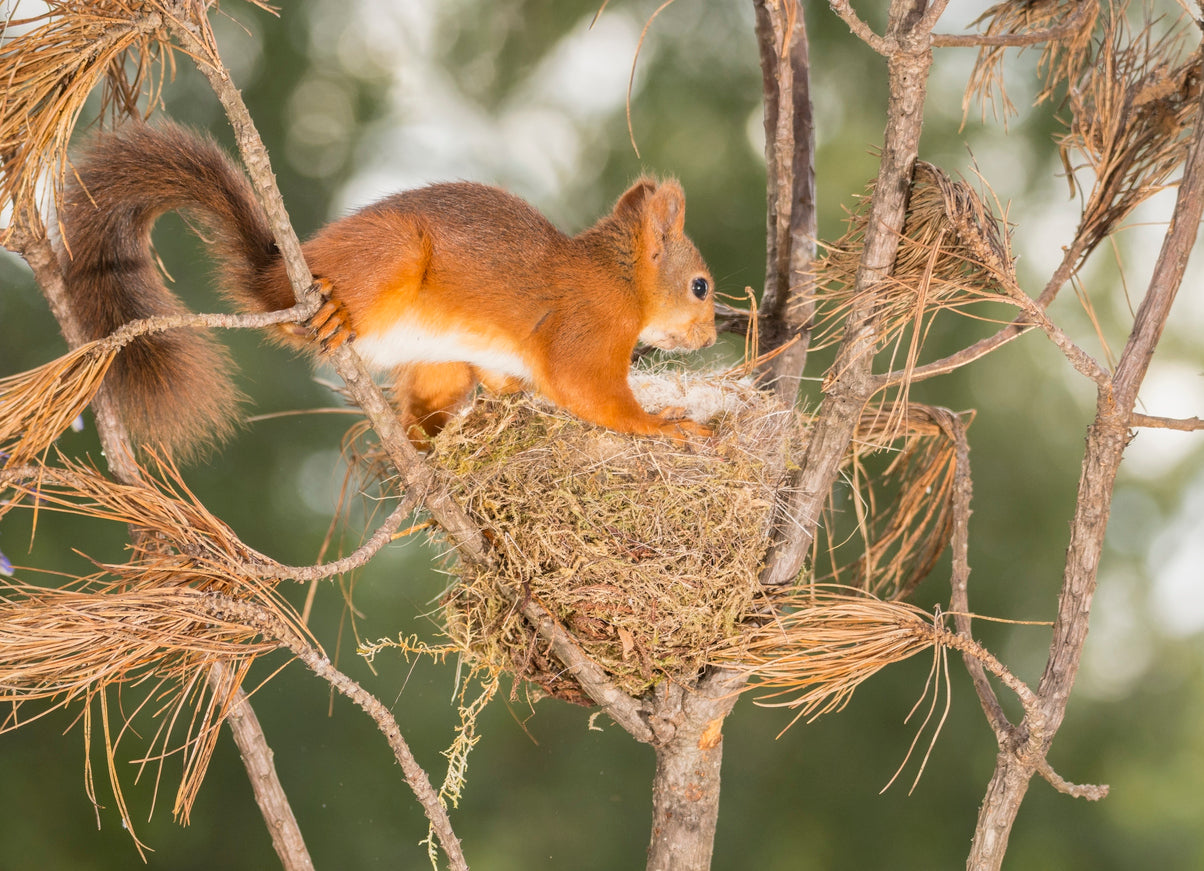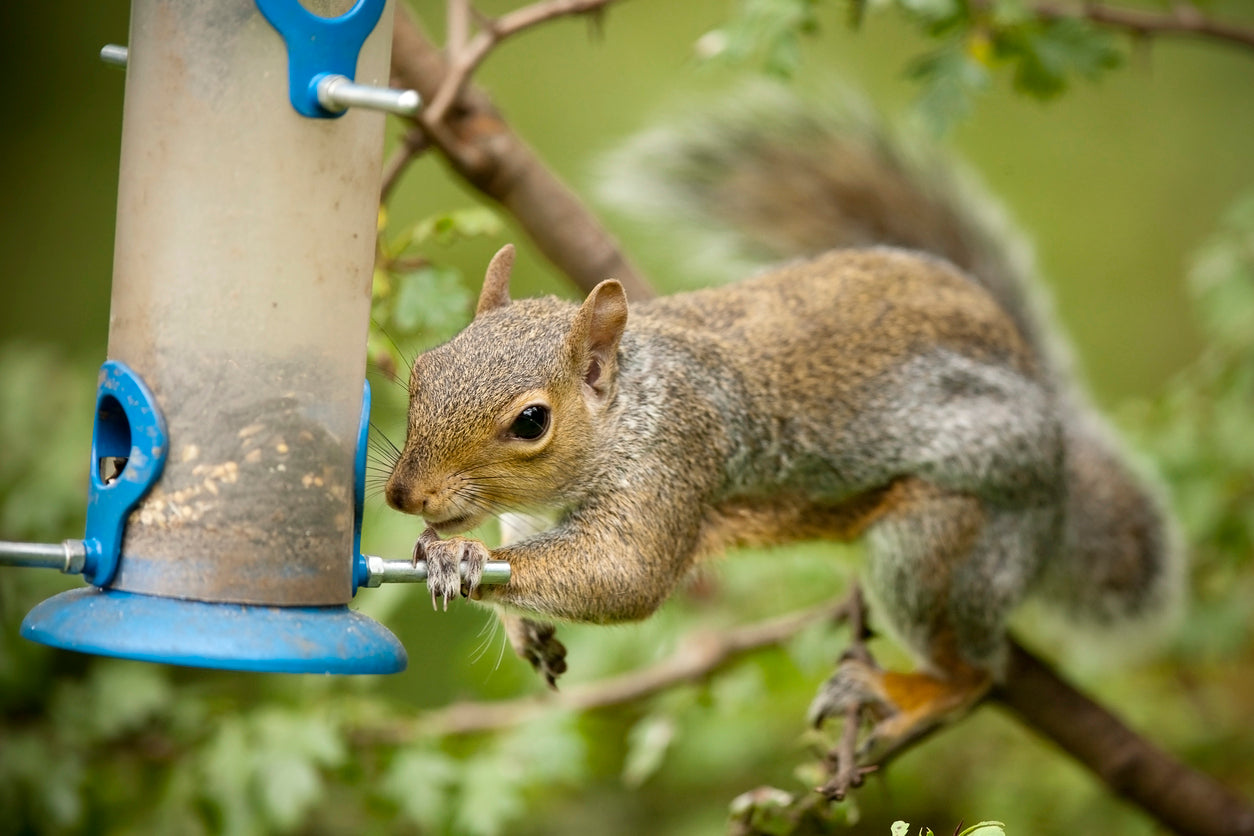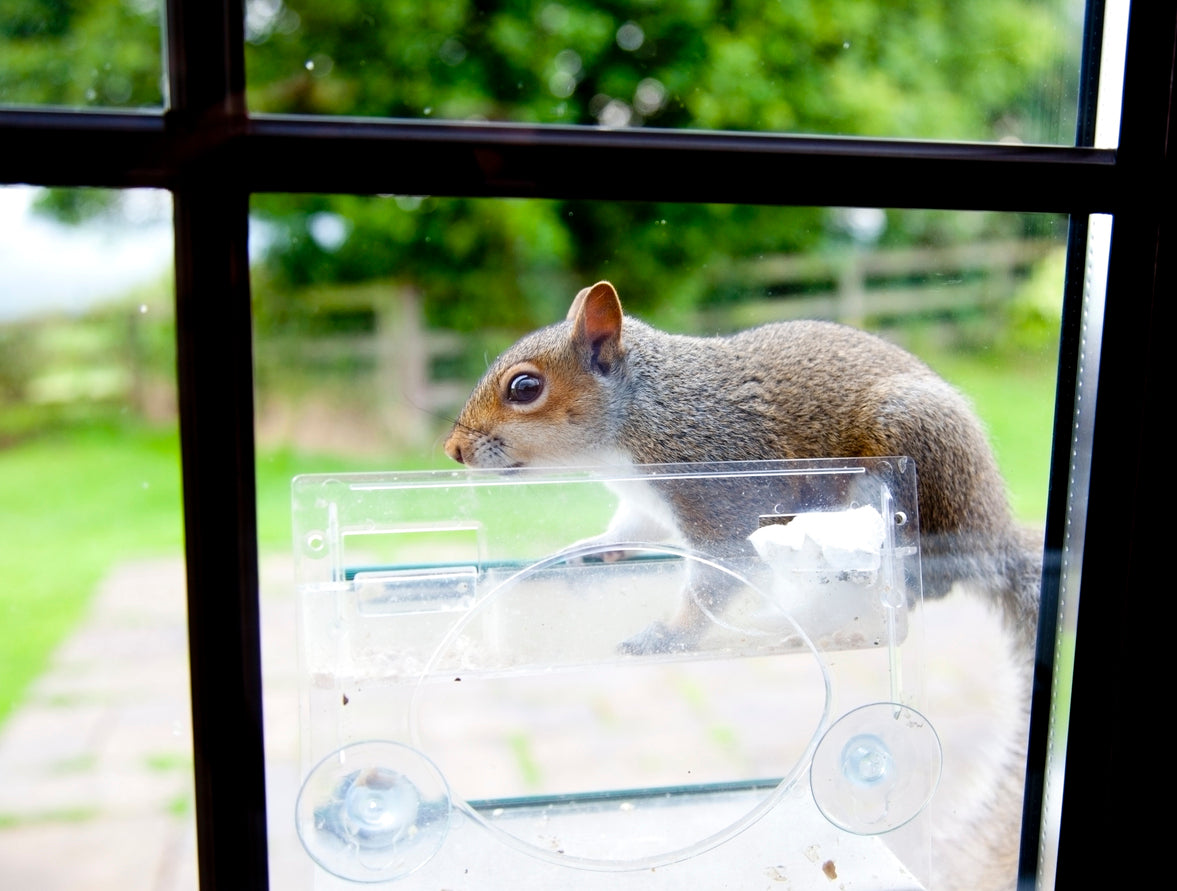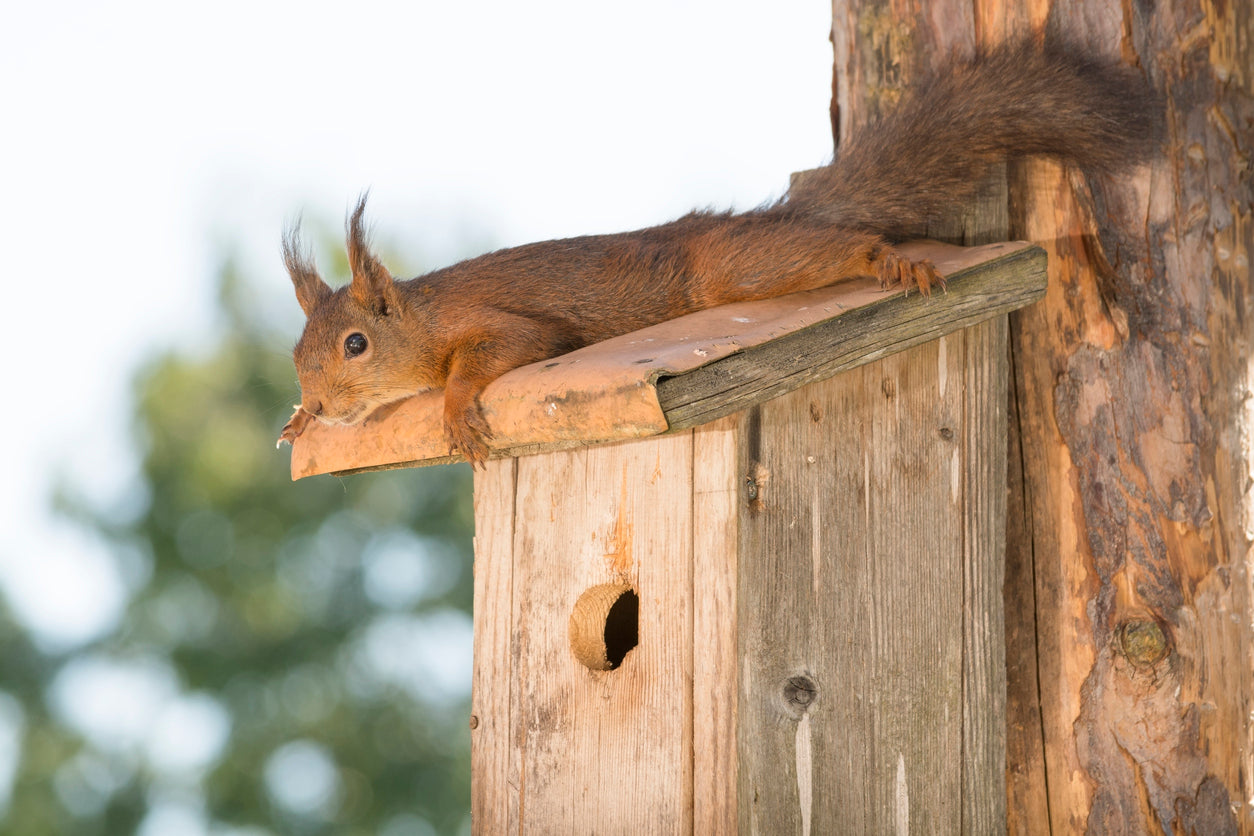-
The pulsing EVICTOR® strobe light is too bright for a squirrels sensitive eyes and disrupts their natural living cycle. After hanging the EVICTOR® strobe light in an attic squirrels usually vacate within 1 to 2 days.
-
30 DAY RETURNS
100% Money Back GuaranteeWe're Confident the EVICTOR® will solve your rodent problems.

Squirrels often nest in attics in homes when they have an available entry point or when trees on or around the property were recently cut down.
Squirrels are often most active in the early mornings and the resulting noise can sometimes be easily heard as scratching on your bedroom ceiling.
A squirrel will often exploit a weak point in the roof line along your home in the fascia board, soffit, flashing areas, valleys, eaves and gables. Once a single hole is made into the home as squirrels begin to enter and exit the attic they will make a 2nd exit hole most often on the opposite side of the attic.
As the squirrels continue to enter and exit the attic space, if the initial holes or routes are left open, they will begin to build a nest tin the attic, create an area to store food and pick a spot to use the bathroom.
Once the nest is established, squirrels will often have babies in the early spring and late summer. All of the squirrel's natural activities that typically took place outside in trees and wooded areas will now take place inside the attic. To survive the winter, squirrels will find that your attic is warm and dry, their nest is safe from wind and rain, and their food pile is untouched by other rodents. They are also safe from predators inside the attic like the hawk or fox because the size of the entrance hole is only about the size of a large egg.
The biggest danger to your home posed by squirrels are house fires caused by squirrels chewing electrical wires. Squirrels need to gnaw to keep their teeth short and wiring in attics is similar to tree branches where you can often see them running the branch through their teeth.
The first instinct you may have is to try and trap the squirrels that are living in your attic and close any entrance and exit holes. The other most common method is to block their access by closing up any holes you may find on the exterior of the home. Unfortunately in many cases these solutions don't work.
Once the life cycle of these squirrels has moved almost entirely into the attic space it becomes very difficult to evict them with home remedies or a simple trap.
Homeowners often report trapping is ineffective against squirrels in attics. Why?
The main reason why trapping is ineffective:
-
The holes were not found or closed after the squirrels were trapped leaving an open entrance to the attic space for nearby squirrels
-
Existing or new squirrels chewed back in after the holes were closed
-
After the nest, food storage and bathroom were established the scent is left behind and the house is now an attractive place for new squirrels moving into the territory
Do not despair! Squirrels naturally build nests in trees and once you give squirrels the proper eviction notice you will no longer have squirrels nesting in your attic.
How Do I Know If I Have Squirrels In My Attic?
Sounds are the #1 complaint, and most obvious sign, of having squirrels in the attic. Odors may not be noticed right away, but be certain that squirrels will decide which area of your attic will be used as their personal bathroom throughout their stay.
Squirrel Nests
Squirrel nests in attics look like piles of leaves and stick bundled together. Outdoors in trees squirrels nests are made with sticks and leaves and look about the size of a soccer ball. Inside attics squirrel nests can keep growing, sometimes exceeding four feet wide. Many homeowners are shocked to find that they have more than one family living inside their attic!
Squirrel Sounds in Attics
Homeowners will often hear clicking sounds coming from the ceiling as squirrels move throughout the attic or crawlspace. These squirrel sounds are most often head in the early morning hours while you are trying to sleep.
Gray Squirrels
Active at dusk and at dawn. You'll hear the most movement early morning and again towards sundown. Squirrels will leave the attic during the warmer parts of the day. Attics get hot quickly, and become too hot during the Summer.
Cooler Temperatures = More Noise During cooler seasons, you may report hearing much more noise. Scurrying, Scratching and Chewing are the most common noises. Chewing is the most dangerous because they could be ruining the integrity of your home and creating a fire hazard. Gray Squirrels will work diligently on your home and try to remain as undetected as possible when it comes to gaining access to your house.
Homeowners rarely catch a gray squirrel in the early stages of figuring out an entry point.
Flying Squirrels
What if the noises are happening at night?
Flying squirrels, on the other hand, are nocturnal! Active throughout the night. You'll hear the most activity beginning at dusk, and on through the night. Chewing, Scratching, and Bumps are the most common noises. Flying Squirrels not only scurry, but they glide from place to place. Large Groups = High Noise Levels! Flying Squirrels live together in large groups. Groups can contain up to 15 adults per group! Flying Squirrels are much smaller than the Gray Squirrel, and can fit in tiny crevices around your attic. The entry points for Flying Squirrels are so small, they're hard to find. Homeowners can watch out for flying squirrel activity as they start to leave the attic at dusk.
Squirrel Odor In Attic
Odor is another tell-tale sign of squirrels in the attic. Squirrels will use portions of the attic as their bathroom, and this scent will be noticeable. In some cases, you will see staining in the ceiling or down a wall. Even if you do not hear the squirrels and you don't see any stains...if squirrels have been in your attic at one time, the odor of their occupation is still there. If there is a foul odor coming from the attic or seeping through a particular room, this means you have or have had tenants in the attic. Flying squirrels will also cause an odor from defecating/urinating in your attic.
Squirrel Nests in Attic
If you find...
A LARGE MOUND made up of Loosely Placed...
twigs
leaves
shredded paper goods
and your own insulation...THIS IS A Gray Squirrel's NEST
A SMALL MOUND made up for Softer Materials...
lichen/moss
leaves
grasses/pine needles
your own insulation...THIS IS A Flying Squirrel's NEST
Flying squirrels have nests that look soft and delicate. All materials used are cushy and come together neatly.
Gray squirrels have nests that look well-built, but a little sloppy. The materials used are much larger and loosely layered.

Damage to Attics by Squirrels Chewing Rafters or Beams
Squirrels may damage rafter beams, chew electrical wires, or generally disrupt things stored in attics and crawlspaces. The biggest threat squirrels pose to homeowners is the possibility of an electrical fire caused by a squirrel chewing on a wire.
Why Do Squirrels Inhabit Attics?
In their natural habitat, squirrels live in trees. Squirrels either choose a hole in a tree to call home, or build a squirrel's nests up high, and securely between branches. Attics are high, dark, warm, and rarely disturbed areas perfect for a squirrel to take refuge from the winter weather.
How often do you go into your own attic? If you rarely use your attic, this is ideal for a squirrel! Attics in houses offer security from the elements and protection from predators for squirrels.
Attics provide a space where squirrels can set up a warm home, store food, and raise a family every year.

Squirrels inhabit attics because of accessibility and security.
How Do Squirrels Enter The Attic?
Consider how a squirrel deals with obstacles...a squirrel can pull apart terra cotta and slate roofs. A squirrel can chew straight through good quality shingles and sturdy wood fascia boards to gain access to your house.
Squirrels are experts at climbing, leaping and chewing. Squirrels can jump five feet in the air, and 10 feet from one point across to another.
Aluminum fascia capping and louvered aluminum gable vents are not impenetrable to a squirrel. Brick is not impenetrable either! Have a loose chimney brick? Squirrels may spot this fault and push that brick in to gain entry.
Squirrels will often widen holes that were previously gaps in construction of fascia board or along ridges leading to attics and crawlspaces. Attic gable vents are favorites for squirrel entry and damage.
How small does a hole have to be for a squirrels to enter?
- Gray Squirrels can move through a hole about the size of a US Quarter.
- Flying Squirrels can fit through a hole the size of a US Nickle.
Although squirrels can fit into a small entry point, they will widen these holes to make travel easier. Squirrels often will make an entrance and an exit hole into an attic or crawlspace. Squirrels want a quick escape from predators in case one hole is under attack! Squirrels will also mark the entry and exit holes as their territory.
Squirrels have the biting power of 22,000 pounds per square inch. They have deep masseter muscles that facilitate this strong gnawing ability. Couple that squirrel trait with a squirrel's evergrowing teeth, and you can see why the squirrel is not only able to chew through some incredible material, but a squirrel must chew!
When you have teeth that are continuously growing, you have to keep them in check. Therefore, gnawing through materials is a must. Vents, pipes, shingles, fans, bricks, wood beams, and unfortunately live wires are all susceptible to squirrel gnawing and access.
If you have an existing hole or loose component to your home, the chances of a squirrel testing it out are high.
When Are Squirrels Most Active In Attics?
You will hear squirrels scampering about your attic mainly at dusk and dawn. You will hear noises early morning, and again through the evening. A squirrel may work alone or in a group to access your attic. If working in a group, these squirrels will work in shifts. During the evening hours, squirrels will mainly chew from the inside of your attic to create their access point.
Remember: Squirrels will usually make two holes into an attic or crawlspace: one entry hole and one exit.
Squirrels move into attics when the weather starts to cool. Squirrels need to prepare for the Winter season by building squirrel nests and storing food!
From Autumn (sometimes late Summer) into Spring, is the stretch of time you will hear the most activity in your attic. Squirrels mate in early Winter and produce offspring by late Spring. A comfortable home is essential for a squirrel family and squirrels will often inhabit attics if trees in yards or nearby brush are cut down and a squirrel loses a nest.
The average squirrel litter consists of four babies. A second litter in mid summer is not uncommon.
How Do I Approach my Attic when Squirrels are Living in the Attic?
Squirrels, especially with babies, can be aggressive.
Before entering your attic, knock on the attic door or ceiling area to alert the squirrels. Play a loud radio at the entrance to discourage any squirrels from approaching the entrance and encourage them to temporarily leave the attic.
If there is a drop staircase, you may slap it against the ceiling a few times before entering the attic. The noise will scare them away so that you can enter without any issues.
Shine a flash-light into the attic or crawlspace before entering to check if any squirrels are present of if there is a nest with babies.
Tips to Prevent Squirrels from Returning
Encourage Squirrels To Stay Out Of Your Home by Following a few Simple Tips.

With any squirrel problem, you should do the things that help your situation:
Remove any nearby bird feeders

Feeding birds from a window mounted bird feeder can also feed nearby squirrels if the feeder is too easily climbed to or jumped on.
Secure garbage cans
Cutting tree limbs away from your roofline will all help you make your attic less accessible and less attractive to squirrels looking to get into an attic.

To accelerate the squirrels move out date, and encourage living outdoors, it is recommended you install a squirrel box in your yard in a nearby tree.
Squirrel boxes provide a quick place for a squirrel to call home, rather than having the squirrels take the time to build an entirely new nest.



Comments
Bill Earl
Hi Krystal,
You can check out the product page for the Evictor 10K for complete pricing and ordering information.
December 15, 2017
krystal kelling
I am certain we have squirrels under our roof line and in the walls. We own a fairly large old home and closing up all the holes is practically impossible. How much does it cost to have this system set up?
May 23, 2017
Leave a comment
Also in Articles
The Best Way to Eliminate Squirrels in Attics, Crawlspaces, Basements, Garages, Cars & More
By Ryan Earl February 23, 2018 4 Comments
Continue reading
Deb Welter of Diamond Rock Wildlife Rehabilition Clinic trusts the Evictor®
By Ryan Earl February 08, 2018
Continue reading
Say No to Poisoning Squirrels in Attics & Crawlspaces
By Ryan Earl January 30, 2018
DON'T Choose to Use Poison for Squirrels
Continue reading